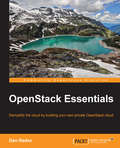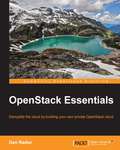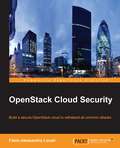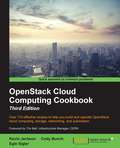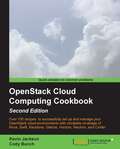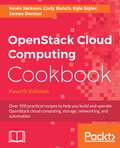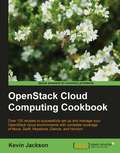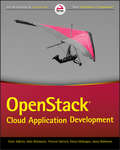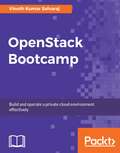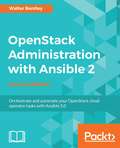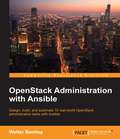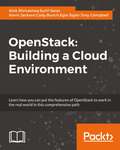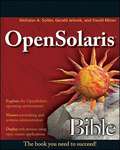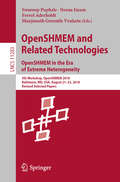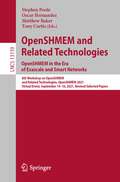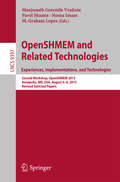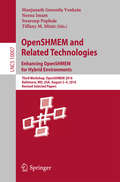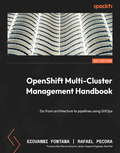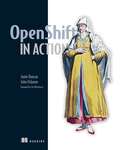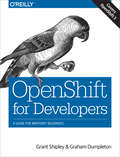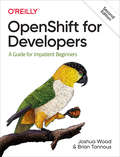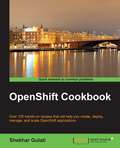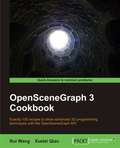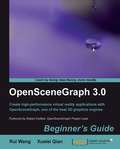- Table View
- List View
OpenStack Essentials
by Dan RadezIf you need to get started with OpenStack or want to learn more, then this book is your perfect companion. If you're comfortable with the Linux command line, you'll gain confidence in using OpenStack.
OpenStack Essentials
by Dan Radez<P><P>Demystify the cloud by building your own private OpenStack cloud <P><P>About This Book <P><P>Set up a powerful cloud platform using OpenStack <P><P>Learn about the components of OpenStack and how they interact with each other <P><P>Follow a step-by-step process that exposes the inner details of an OpenStack cluster <P><P>Who This Book Is For <P><P>If you need to get started with OpenStack or want to learn more, then this book is your perfect companion. If you're comfortable with the Linux command line, you'll gain confidence in using OpenStack. <P><P>What You Will Learn <P><P>Install OpenStack using the Packstack installation tool <P><P>Create users, cloud images, and virtual networks to launch cloud instances <P><P>Explore horizontal scaling to support the load that a cloud platform is expected to handle <P><P>Set up monitoring to keep track of the health of an OpenStack cloud <P><P>Troubleshoot issues with an OpenStack cluster <P><P>Build storage and access it from your running cloud instances <P><P>Orchestrate a multi-instance deployment to build a complex set of virtual infrastructure to run an application in the cloud <P><P>Keep track of resources being consumed within an OpenStack cloud through metering <P><P>In Detail <P><P>An OpenStack cloud is a complex jungle of components that can speed up managing a virtualization platform. Applications that are built for this platform are resilient to failure and convenient to scale. OpenStack allows administrators and developers to consolidate and control pools of compute, networking, and storage resources, with a centralized dashboard and administration panel to enable the large-scale development of cloud services. <P><P>Begin by exploring and unravelling the internal architecture of the OpenStack cloud components. After installing the RDO distribution, you will be guided through each component via hands-on exercises, learning more about monitoring and troubleshooting the cluster. By the end of the book, you'll have the confidence to install, configure, and administer an OpenStack cloud. <P><P>This is a practical and comprehensive tutorial on sorting out the complexity of an OpenStack cloud.
OpenStack Cloud Security
by Fabio Alessandro LocatiIf you are an OpenStack administrator or developer, or wish to build solutions to protect your OpenStack environment, then this book is for you. Experience of Linux administration and familiarity with different OpenStack components is assumed.
OpenStack Cloud Computing Cookbook - Third Edition
by Cody Bunch Kevin JacksonThis book is aimed at cloud system engineers, system administrators, and technical architects who are moving from a virtualized environment to cloud environments. This book assumes that you are familiar with cloud computing platforms, and have knowledge of virtualization, networking, and managing Linux environments.
OpenStack Cloud Computing Cookbook, Second Edition
by Kevin Jackson Cody BunchA Cookbook full of practical and applicable recipes that will enable you to use the full capabilities of OpenStack like never before.This book is aimed at system administrators and technical architects moving from a virtualized environment to cloud environments with familiarity of cloud computing platforms. Knowledge of virtualization and managing linux environments is expected.
OpenStack Cloud Computing Cookbook - Fourth Edition: Over 100 practical recipes to help you build and operate OpenStack cloud computing, storage, networking, and automation
by Kevin Jackson James Denton Cody Bunch Egle SiglerThe Fourth Edition of the industry-acclaimed OpenStack Cloud Computing Cookbook, from four recognized experts, updated to the latest OpenStack build including Cinder, Nova, and Neutron. Key Features Over 100 recipes created by a team of OpenStack experts Updated to work with the latest OpenStack builds, with recipes covering the installation and use of OpenStack with Ansible It covers topics such as Keystone, Glance, Neutron, Nova, Cinder, and more, plus recipes for OpenStack storage, networking, and orchestrating workloads Test drive OpenStack using the accompanying Vagrant environment Book Description This is the fourth edition of the industry-acclaimed OpenStack Cloud Computing Cookbook, created by four recognized OpenStack experts. It has now been updated to work with the latest OpenStack builds, using tools and processes based on their collective and vast OpenStack experience. OpenStack Open Source Cloud software is one of the most used cloud infrastructures to support a wide variety of use cases, from software development to big data analysis. It is developed by a thriving community of individual developers from around the globe and backed by most of the leading players in the cloud space today. We make it simple to implement, massively scalable, and able to store a large pool of data and networking resources. OpenStack has a strong ecosystem that helps you provision your cloud storage needs. Add OpenStack's enterprise features to reduce the cost of your business. This book will begin by showing you the steps to build up an OpenStack private cloud environment using Ansible. You'll then discover the uses of cloud services such as the identity service, image service, and compute service. You'll dive into Neutron, the OpenStack Networking service, and get your hands dirty with configuring networks, routers, load balancers, and more. You’ll then gather more expert knowledge on OpenStack cloud computing by managing your cloud's security and migration. After that, we delve into OpenStack Object storage and you’ll see how to manage servers and work with objects, cluster, and storage functionalities. Finally, you will learn about OpenStack dashboard, Ansible, Keystone, and other interesting topics. What you will learn Understand, install, configure, and manage a complete OpenStack Cloud platform using OpenStack-Ansible Configure networks, routers, load balancers, and more with Neutron Use Keystone to setup domains, roles, groups and user access Learn how to use Swift and setup container access control lists Gain hands-on experience and familiarity with Horizon, the OpenStack Dashboard user interface Automate complete solutions with our recipes on Heat, the OpenStack Orchestration service as well as using Ansible to orchestrate application workloads Follow practical advice and examples to run OpenStack in productionWho this book is for This book is written for cloud system engineers, system administrators, and technical architects who are moving from a virtualized environment to cloud environments. This book assumes that you are familiar with cloud computing platforms, and have knowledge of virtualization, networking, and managing Linux environments.
OpenStack Cloud Computing Cookbook Fourth Edition: Over 100 Practical Recipes To Help You Build And Operate Openstack Cloud Computing, Storage, Networking, And Automation
by Kevin Jackson James Denton Cody Bunch Egle SiglerKey Features Over 100 recipes created by a team of OpenStack experts Updated to work with the latest OpenStack builds, with recipes covering the installation and use of OpenStack with Ansible It covers topics such as Keystone, Glance, Neutron, Nova, Cinder, and more, plus recipes for OpenStack storage, networking, and orchestrating workloads Test drive OpenStack using the accompanying Vagrant environment Book Description This is the fourth edition of the industry-acclaimed OpenStack Cloud Computing Cookbook, created by four recognized OpenStack experts. It has now been updated to work with the latest OpenStack builds, using tools and processes based on their collective and vast OpenStack experience. OpenStack Open Source Cloud software is one of the most used cloud infrastructures to support a wide variety of use cases, from software development to big data analysis. It is developed by a thriving community of individual developers from around the globe and backed by most of the leading players in the cloud space today. We make it simple to implement, massively scalable, and able to store a large pool of data and networking resources. OpenStack has a strong ecosystem that helps you provision your cloud storage needs. Add OpenStack's enterprise features to reduce the cost of your business. This book will begin by showing you the steps to build up an OpenStack private cloud environment using Ansible. You'll then discover the uses of cloud services such as the identity service, image service, and compute service. You'll dive into Neutron, the OpenStack Networking service, and get your hands dirty with configuring networks, routers, load balancers, and more. You'll then gather more expert knowledge on OpenStack cloud computing by managing your cloud's security and migration. After that, we delve into OpenStack Object storage and you'll see how to manage servers and work with objects, cluster, and storage functionalities. Finally, you will learn about OpenStack dashboard, Ansible, Keystone, and other interesting topics. <P><P>What you will learn <P><P>Understand, install, configure, and manage a complete OpenStack Cloud platform using OpenStack-Ansible <P><P>Configure networks, routers, load balancers, and more with Neutron <P><P>Use Keystone to setup domains, roles, groups and user access <P><P>Learn how to use Swift and setup container access control lists <P><P>Gain hands-on experience and familiarity with Horizon, the OpenStack Dashboard user interface <P><P>Automate complete solutions with our recipes on Heat, the OpenStack Orchestration service as well as using Ansible to orchestrate application workloads <P><P>Follow practical advice and examples to run OpenStack in production
OpenStack Cloud Computing Cookbook
by Kevin JacksonA Cookbook full of practical and applicable recipes that will enable you to use the full capabilities of OpenStack like never before. This book is aimed at system administrators and technical architects moving from a virtualized environment to cloud environments with familiarity of cloud computing platforms. Knowledge of virtualization and managing linux environments is expected.
OpenStack Cloud Application Development
by Jason E. Robinson Vincent Giersch Scott Adkins John Belamaric Denys MakogonLeverage the power of OpenStack to develop scalable applications with no vendor lock-in OpenStack Cloud Application Development is a fast-paced, professional book for OpenStack developers, delivering comprehensive guidance without wasting time on development fundamentals. Written by experts in the OpenStack community from Infoblox, Gigaspaces, GoDaddy, and Comcast, this book shows you how to work effectively and efficiently within the OpenStack platform to develop large, scalable applications without worrying about underlying hardware. Follow along with an OpenStack build that illustrates how and where each technology comes into play, as you learn expert tips and best practices that make your product stronger. Coverage includes OpenStack service primitives, networking within the OpenStack Ecosystem, deployment of Virtualized Network Functions for Enterprises, containers, data protection, and much more. If you need to get on board quickly, this professional book is your ideal roadmap to OpenStack development. Understand all aspects of OpenStack technologies Follow an example build to drill down into critical elements Learn the OpenStack best practices and insider tips Leverage the full capability of IaaS at a professional pace OpenStack is supported by dozens of major technology companies, compatible with Amazon Web Services, and can be used alongside or on top of VMWare vSphere and other similar technologies. It frees developers from the confines of hardware and vendor lock-in while providing a reliable, fast, and easy platform for developing scalable cloud applications. OpenStack Cloud Application Development is an expert-led guide to getting the most out of OpenStack, designed specifically for the professional developer.
OpenStack Bootcamp
by Vinoth Kumar SelvarajA focused and systematic introduction to OpenStack, the largest open source cloud platform, using practical examples and hands-on problems. About This Book • Explore all the new features of OpenStack's Mikata, Ocata, and Newton releases and get up to speed with OpenStack in no time • Learn something new each day to successfully build a private cloud platform • A fast-paced guide filled with best practices that will help you manage your virtual private cloud efficiently Who This Book Is For This book is for those who are already familiar with OpenStack's supporting technologies. It's ideal for cloud system engineers, system administrators, and technical architects who are moving from a virtualized environment to a cloud environment. Prior knowledge of cloud computing platforms and virtualization would be beneficial. If you are a system or cloud engineer, this is your go-to book! What You Will Learn • Understand the functions and features of each core component of OpenStack and a real-world comparison • Develop an understanding of the components of IaaS and PaaS clouds built with OpenStack • Get a high-level understanding of architectural design in OpenStack • Discover how you can use OpenStack Horizon with all of the OpenStack core components • Understand network traffic flow with Neutron • Build an OpenStack private cloud from scratch • Get hands-on training with the OpenStack command line, administration, and deployment In Detail OpenStack is developed by a thriving community of individual developers around the globe and is backed by most of the leading players in the cloud space today. OpenStack is a free and open source software platform for cloud computing, mostly deployed as an infrastructure-as-a-service (IaaS). This book begins with the design principles of OpenStack and the available OpenStack distributions. You'll start by getting a fundamental understanding of the core concepts and then move on to a comparison of OpenStack components with real-life examples. Then, we'll show you the typical architecture of OpenStack clouds, how to configure each OpenStack component, and debugging techniques. Later, we focus on the latest releases of OpenStack: Mikata, Newton, and Ocata. You'll be introduced to identity, image, networking, and the compute service. You'll also get a complete understanding of how to install, configure, and administrate your entire virtual private cloud. You will also be provided with hands-on exercises to unleash the power of each component in OpenStack. Finally, you'll see an overview of all the optional projects available under the Openstack umbrella. Style and approach This fast-paced book delivers comprehensive hands-on training, so you can jump straight into the practical exercises along with in-depth coverage of OpenStack technologies. It also provides hands-on exercises, analysis of real-world cloud use cases and operation scenarios, covering design, customization and optimization.
OpenStack Administration with Ansible 2 - Second Edition
by Walter BentleyOrchestrate and automate your OpenStack cloud operator tasks with Ansible 2.0 About This Book • Automate real-world OpenStack cloud operator administrative tasks • Construct a collection of the latest automation code to save time on managing your OpenStack cloud • Manage containers on your cloud and check the health of your cloud using Nagios Who This Book Is For This book is aimed at OpenStack-based cloud operators and infrastructure and sys administrators who have some knowledge of OpenStack and are seeking to automate taxing and manual tasks. This book is also for people new to automating cloud operations in general and the DevOps practice in particular. What You Will Learn • Efficiently execute OpenStack administrative tasks • Familiarize yourself with how Ansible 2 works and assess the defined best practices • Create Ansible 2 playbooks and roles • Automate tasks to customize your OpenStack cloud • Review OpenStack automation considerations when automating administrative tasks • Examine and automate advanced OpenStack tasks and designated use cases • Get a high-level overview of OpenStack and current production-ready projects • Explore OpenStack CLI tools and learn how to use them In Detail Most organizations are seeking methods to improve business agility because they have realized just having a cloud is not enough. Being able to improve application deployments, reduce infrastructure downtime, and eliminate daily manual tasks can only be accomplished through some sort of automation. We start with a brief overview of OpenStack and Ansible 2 and highlight some best practices. Each chapter will provide an introduction to handling various Cloud Operator administration tasks such as managing containers within your cloud; setting up/utilizing open source packages for monitoring; creating multiple users/tenants; taking instance snapshots; and customizing your cloud to run multiple active regions. Each chapter will also supply a step-by-step tutorial on how to automate these tasks with Ansible 2. Packed with real-world OpenStack administrative tasks, this book will walk you through working examples and explain how these tasks can be automated using one of the most popular open source automation tools on the market today. Style and approach This book is a concise, fast-paced guide filled with real-world scenarios that will execute OpenStack administrative tasks efficiently. It serves as a quick reference guide for not just OpenStack functions, but also for creating future Ansible code.
OpenStack Administration with Ansible
by Walter BentleyDesign, build, and automate 10 real-world OpenStack administrative tasks with Ansible About This Book * Automate real-world OpenStack cloud operator administrative tasks * Construct a collection of automation code to save time on managing your OpenStack cloud * Use this step-by-step tutorial to automate such tasks with Ansible Who This Book Is For If you are an OpenStack-based cloud operator and/or infrastructure administrator and are interested in automating administrative functions, then this book is exactly what you are looking for. Having a functioning OpenStack environment is helpful, but most certainly not necessary. What You Will Learn * Efficiently execute OpenStack administrative tasks * Familiarize yourself with how Ansible works and assess the defined best practices * Create Ansible playbooks and roles * Automate tasks to customize your OpenStack cloud * Review OpenStack automation considerations when automating administrative tasks * Examine and automate advanced OpenStack tasks and designated use cases * Get a high-level overview of OpenStack and the current production-ready projects * Deep dive into OpenStack CLI tools and find out how to use them In Detail Most organizations are seeking methods to improve business agility because they have realized just having a cloud is not enough. Being able to improve application deployments, reduce infrastructure downtime, and eliminate daily manual tasks can only be accomplished through some sort of automation. Packed with real-world OpenStack administrative tasks, this book will walk you through working examples and explain how these tasks can be automated using one of the most popular open source automation tools--Ansible. We will start with a brief overview of OpenStack and Ansible and highlight some best practices. Each chapter will provide an introduction to handling various Cloud Operator administration tasks such as creating multiple users/tenants, setting up Multi-Tenant Isolation, customizing your clouds quotas, taking instance snapshots, evacuating compute hosts for maintenance, and running cloud health checks, and a step-by-step tutorial on how to automate these tasks with Ansible. Style and approach This easy-to-follow reference guide is packed with examples of real-world OpenStack administration tasks; each task is explained in detail and then subsequently turned into automation code.
OpenStack: Building a Cloud Environment
by Tony Campbell Kevin Jackson Alok Shrivastwa Egle Sigler Sunil Sarat Cody BunchLearn how you can put the features of OpenStack to work in the real world in this comprehensive path About This Book * Harness the abilities of experienced OpenStack administrators and architects, and run your own private cloud successfully * Learn how to install, configure, and manage all of the OpenStack core projects including topics on Object Storage, Block Storage, and Neutron Networking services such as LBaaS and FWaaS * Get better equipped to troubleshoot and solve common problems in performance, availability, and automation that confront production-ready OpenStack environments Who This Book Is For This course is for those who are new to OpenStack who want to learn the cloud networking fundamentals and get started with OpenStack networking. Basic understanding of Linux Operating System, Virtualization, and Networking, and Storage principles will come in handy. What You Will Learn * Get an introduction to OpenStack and its components * Store and retrieve data and images using storage components, such as Cinder, Swift, and Glance * Install and configure Swift, the OpenStack Object Storage service, including configuring Container Replication between datacenters * Gain hands on experience and familiarity with Horizon, the OpenStack Dashboard user interface * Learn how to automate OpenStack installations using Ansible and Foreman * Follow practical advice and examples for running OpenStack in production * Fix common issues with images served through Glance and master the art of troubleshooting Neutron networking In Detail OpenStack is a collection of software projects that work together to provide a cloud fabric. Learning OpenStack Cloud Computing course is an exquisite guide that you will need to build cloud environments proficiently. This course will help you gain a clearer understanding of OpenStack's components and their interaction with each other to build a cloud environment. The first module, Learning OpenStack, starts with a brief look into the need for authentication and authorization, the different aspects of dashboards, cloud computing fabric controllers, along with 'Networking as a Service' and 'Software defined Networking'. Then, you will focus on installing, configuring, and troubleshooting different architectures such as Keystone, Horizon, Nova, Neutron, Cinder, Swift, and Glance. After getting familiar with the fundamentals and application of OpenStack, let's move deeper into the realm of OpenStack. In the second module, OpenStack Cloud Computing Cookbook, preview how to build and operate OpenStack cloud computing, storage, networking, and automation. Dive into Neutron, the OpenStack Networking service, and get your hands dirty with configuring ML2, networks, routers, and distributed virtual routers. Further, you'll learn practical examples of Block Storage, LBaaS, and FBaaS. The final module, Troubleshooting OpenStack, will help you quickly diagnose, troubleshoot, and correct problems in your OpenStack. We will diagnose and remediate issues in Keystone, Glance, Neutron networking, Nova, Cinder block storage, Swift object storage, and issues caused by Heat orchestration. This Learning Path combines some of the best that Packt has to offer in one complete, curated package. It includes content from the following Packt products: * Learning OpenStack by Alok Shrivastwa, Sunil Sarat * OpenStack Cloud Computing Cookbook - Third Edition by Kevin Jackson , Cody Bunch, Egle Sigler * Troubleshooting OpenStack by Tony Campbell Style and approach This course aims to create a smooth learning path that will teach you how to get started with setting up private and public clouds using a free and open source cloud computing platform--OpenStack. Through this comprehensive course, you'll learn OpenStack Cloud computing from scratch to finish and more!"
OpenSolaris Bible
by Nicholas A. SolterAfter a beginning overview of the history of OpenSolaris, its open-source licensing, and the community development model, this book then goes on to highlight the aspects of OpenSolaris that differ from more familiar operating systems. You'll learn how to become a power user of OpenSolaris by maximizing the abilities of advanced features like Dtrace, the fault management architecture, ZFS, the service management facility, and Zones. Authors provide insider tips, unique tricks, and practical examples to help you stay sharp with the latest features of OpenSolaris.
OpenSHMEM and Related Technologies. OpenSHMEM in the Era of Extreme Heterogeneity: 5th Workshop, Openshmem 2018, Baltimore, Md, Usa, August 21-23, 2018, Revised Selected Papers (Lecture Notes in Computer Science #11283)
by Swaroop Pophale Neena Imam Ferrol Aderholdt Manjunath Gorentla VenkataThis book constitutes the proceedings of the 5th OpenSHMEM Workshop, held in Baltimore, MD, USA, in August 2018. <P><P> The 14 full papers presented in this book were carefully reviewed and selected for inclusion in this volume. The papers discuss a variety of ideas for extending the OpenSHMEM specification and discuss a variety of concepts, including interesting use of OpenSHMEM in HOOVER – a distributed, flexible, and scalable streaming graph processor and scaling OpenSHMEM to handle massively parallel processor arrays. The papers are organized in the following topical sections: OpenSHMEM library extensions and implementations; OpenSHMEM use and applications; and OpenSHMEM simulators, tools, and benchmarks.
OpenSHMEM and Related Technologies. OpenSHMEM in the Era of Exascale and Smart Networks: 8th Workshop on OpenSHMEM and Related Technologies, OpenSHMEM 2021, Virtual Event, September 14–16, 2021, Revised Selected Papers (Lecture Notes in Computer Science #13159)
by Stephen Poole Oscar Hernandez Matthew Baker Tony CurtisThis book constitutes the proceedings of the 8th OpenSHMEM Workshop, held in virtually in August 2021. The 11 full papers and 1 short paper presented in this book were carefully reviewed and selected for inclusion in this volume from 18 submissions. The papers are organized in the following topical sections: Applications and Implementations, Tools and Benchmarks, and Applications and Implementations.
OpenSHMEM and Related Technologies. Experiences, Implementations, and Technologies
by Manjunath Gorentla Venkata Pavel Shamis Neena Imam M. Graham LopezThis book constitutes the proceedings of the SecondOpenSHMEM Workshop, held in Annapolis, MD, USA, in August 2015. The 12 technical papers and one short position paperspresented in this book were carefully reviewed and selected from 17submissions. The topics of the workshop included extensions to the OpenSHMEMAPI, implementation of the API for current and emerging architectures, tools todebug and profile OpenSHMEM programs, experience porting applications to theOpenSHMEM programming model, and changes to the OpenSHMEM specification toaddress the needs of programming exascale systems.
OpenSHMEM and Related Technologies. Enhancing OpenSHMEM for Hybrid Environments
by Manjunath Gorentla Venkata Neena Imam Swaroop Pophale Tiffany M. MintzThis book constitutes the proceedings of the Third OpenSHMEM Workshop, held in Baltimore, MD, USA, in August 2016. The 14 full papers and 3 short papers presented were carefully reviewed and selected from 25 submissions. The papers discuss a variety of ideas of extending the OpenSHMEM specification and making it efficient for current and next generation systems. This included active messages, non-blocking APIs, fault tolerance capabitlities, exploring implementation of OpenSHMEM using communication layers such as OFI and UCX and implementing OpenSHMEM for heterogeneous architectures.
OpenShift Multi-Cluster Management Handbook: Go from architecture to pipelines using GitOps
by Giovanni Fontana Rafael Pecora Marcos AmorimDiscover best practices for designing and scaling robust OpenShift clusters' architecture for different workloadsManage multiple clusters on-premise or in the cloud using multi-cluster management tools to keep them secure and compliantImplement multi-cluster CI/CD on OpenShift using GitOpsKey FeaturesDiscover best practices to design robust OpenShift architecture and scale them to different workloadsUnderstand the minimal collection of topics you should consider in your container security strategyImplement multi-cluster CI/CD on OpenShift using GitOpsBook DescriptionFor IT professionals working with Red Hat OpenShift Container Platform, the key to maximizing efficiency is understanding the powerful and resilient options to maintain the software development platform with minimal effort. OpenShift Multi-Cluster Management Handbook is a deep dive into the technology, containing knowledge essential for anyone who wants to work with OpenShift.This book starts by covering the architectural concepts and definitions necessary for deploying OpenShift clusters. It then takes you through designing Red Hat OpenShift for hybrid and multi-cloud infrastructure, showing you different approaches for multiple environments (from on-premises to cloud providers). As you advance, you'll learn container security strategies to protect pipelines, data, and infrastructure on each layer. You'll also discover tips for critical decision making once you understand the importance of designing a comprehensive project considering all aspects of an architecture that will allow the solution to scale as your application requires.By the end of this OpenShift book, you'll know how to design a comprehensive Red Hat OpenShift cluster architecture, deploy it, and effectively manage your enterprise-grade clusters and other critical components using tools in OpenShift Plus.What you will learnUnderstand the important aspects of OpenShift cluster architectureDesign your infrastructure to run across hybrid cloudsDefine the best strategy for multitenancy on OpenShiftDiscover efficient troubleshooting strategies with OpenShiftBuild and deploy your applications using OpenShift Pipelines (Tekton)Work with ArgoCD to deploy your applications using GitOps practicesMonitor your clusters' security using Red Hat Advanced Cluster SecurityWho this book is forThis book is for a wide range of IT professionals using or looking to use OpenShift with a hybrid/multi-cloud approach. In this book, IT architects will find practical guidance on OpenShift clusters' architecture, while Sysadmins, SREs, and IT operators will learn more about OpenShift deployment, troubleshooting, networking, security, and tools to manage multiple clusters from a single pane. For DevOps engineers, this book covers CI/CD strategies for multiple clusters using GitOps. Equipped with just basic knowledge of containerization and Kubernetes, you're ready to get started.
OpenShift in Action
by John Osborne Jamie DuncanSummaryOpenShift in Action is a full reference to Red Hat OpenShift that breaks down this robust container platform so you can use it day-to-day. Combining Docker and Kubernetes, OpenShift is a powerful platform for cluster management, scaling, and upgrading your enterprise apps. It doesn't matter why you use OpenShift—by the end of this book you'll be able to handle every aspect of it, inside and out! Foreword by Jim Whitehurst, Red Hat. Purchase of the print book includes a free eBook in PDF, Kindle, and ePub formats from Manning Publications.About the TechnologyContainers let you package everything into one neat place, and with Red Hat OpenShift you can build, deploy, and run those packages all in one place! Combining Docker and Kubernetes, OpenShift is a powerful platform for cluster management, scaling, and upgrading your enterprise apps.About the BookOpenShift in Action is a full reference to Red Hat OpenShift that breaks down this robust container platform so you can use it day-to-day. Starting with how to deploy and run your first application, you'll go deep into OpenShift. You'll discover crystal-clear explanations of namespaces, cgroups, and SELinux, learn to prepare a cluster, and even tackle advanced details like software-defined networks and security, with real-world examples you can take to your own work. It doesn't matter why you use OpenShift—by the end of this book you'll be able to handle every aspect of it, inside and out! What's InsideWritten by lead OpenShift architectsRock-solid fundamentals of Docker and KubernetesKeep mission-critical applications up and runningManage persistent storageAbout the ReaderFor DevOps engineers and administrators working in a Linux-based distributed environment.About the AuthorsJamie Duncan is a cloud solutions architect for Red Hat, focusing on large-scale OpenShift deployments. John Osborne is a principal OpenShift architect for Red Hat.Table of ContentsPART 1 - FUNDAMENTALSGetting to know OpenShift Getting started Containers are Linux PART 2 - CLOUD-NATIVE APPLICATIONSWorking with services Autoscaling with metrics Continuous integration and continuous deployment PART 3 - STATEFUL APPLICATIONS Creating and managing persistent storage Stateful applications PART 4 - OPERATIONS AND SECURITYAuthentication and resource access Networking Security
OpenShift for Developers: A Guide for Impatient Beginners
by Graham Dumpleton Grant ShipleyKeen to build web applications for the cloud? Get a quick hands-on introduction to OpenShift, the open source Platform as a Service (PaaS) offering from Red Hat. With this practical guide, you’ll learn the steps necessary to build, deploy, and host a complete real-world application on OpenShift without having to slog through long, detailed explanations of the technologies involved. OpenShift enables you to use Docker application containers and the Kubernetes cluster manager to automate the way you create, ship, and run applications. Through the course of the book, you’ll learn how to use OpenShift and the Wildfly application server to build and then immediately deploy a Java application online. Learn about OpenShift’s core technology, including Docker-based containers and Kubernetes; Use a virtual machine with OpenShift installed and configured on your local environment; Create and deploy your first application on the OpenShift platform; Add language runtime dependencies and connect to a database; Trigger an automatic rebuild and redeployment when you push changes to the repository; Get a working environment up in minutes with application templates; Use commands to check and debug your application; Create and build Docker-based images for your application.
OpenShift for Developers
by Joshua Wood Brian TannousReady to build cloud native applications? Get a hands-on introduction to daily life as a developer crafting code on OpenShift, the open source container application platform from Red Hat. Creating and packaging your apps for deployment on modern distributed systems can be daunting. Too often, adding infrastructure value can complicate development. With this practical guide, you'll learn how to build, deploy, and manage a multitiered application on OpenShift.Authors Joshua Wood and Brian Tannous, principal developer advocates at Red Hat, demonstrate how OpenShift speeds application development. With the Kubernetes container orchestrator at its core, OpenShift simplifies and automates the way you build, ship, and run code. You'll learn how to use OpenShift and the Quarkus Java framework to develop and deploy apps using proven enterprise technologies and practices that you can apply to code in any language.Learn the development cycles for building and deploying on OpenShift, and the tools that drive themUse OpenShift to build, deploy, and manage the ongoing lifecycle of an n-tier applicationCreate a continuous integration and deployment pipeline to build and deploy application source code on OpenShiftAutomate scaling decisions with metrics and trigger lifecycle events with webhooks
OpenShift Cookbook
by Shekhar GulatiIf you are a web application developer who wants to use the OpenShift platform to host your next big idea but are looking for guidance on how to achieve this, then this book is the first step you need to take. This is a very accessible cookbook where no previous knowledge of OpenShift is needed.
OpenSceneGraph 3 Cookbook
by Rui Wang Xuelei QianThis is a cookbook full of recipes with practical examples enriched with code and the required screenshots for easy and quick comprehension. You should be familiar with the basic concepts of the OpenSceneGraph API and should be able to write simple programs. Some OpenGL and math knowledge will help a lot, too.
OpenSceneGraph 3.0: Beginner's Guide
by Rui Wang Xuelei QianWritten with a fast-paced but friendly and engaging approach, this Packt Beginner's Guide is designed to be placed alongside the computer as your guide and mentor. Step-by-step tutorials are bolstered by explanations of the reasoning behind what you are doing. You will quickly pick up the necessary skills, tips, and tricks for creating successful 3D graphics with practical examples that help you to learn by experiment and play.This book is intended for software developers who are new to OpenSceneGraph and considering using it in their applications. It is assumed that you have basic knowledge of C++ before using this book, especially the standard template library (STL) constructs, of which OSG makes extensive use. Some familiarity with design patterns as implemented in C++ is also useful, but is not required.You need to be familiar with OpenGL, the standard cross-platform low-level 3D graphics API. We'll meet some maths in the book--geometry and linear algebra--and familiarity with these topics will be great, but you don't need to be a maths whiz to use this book.
